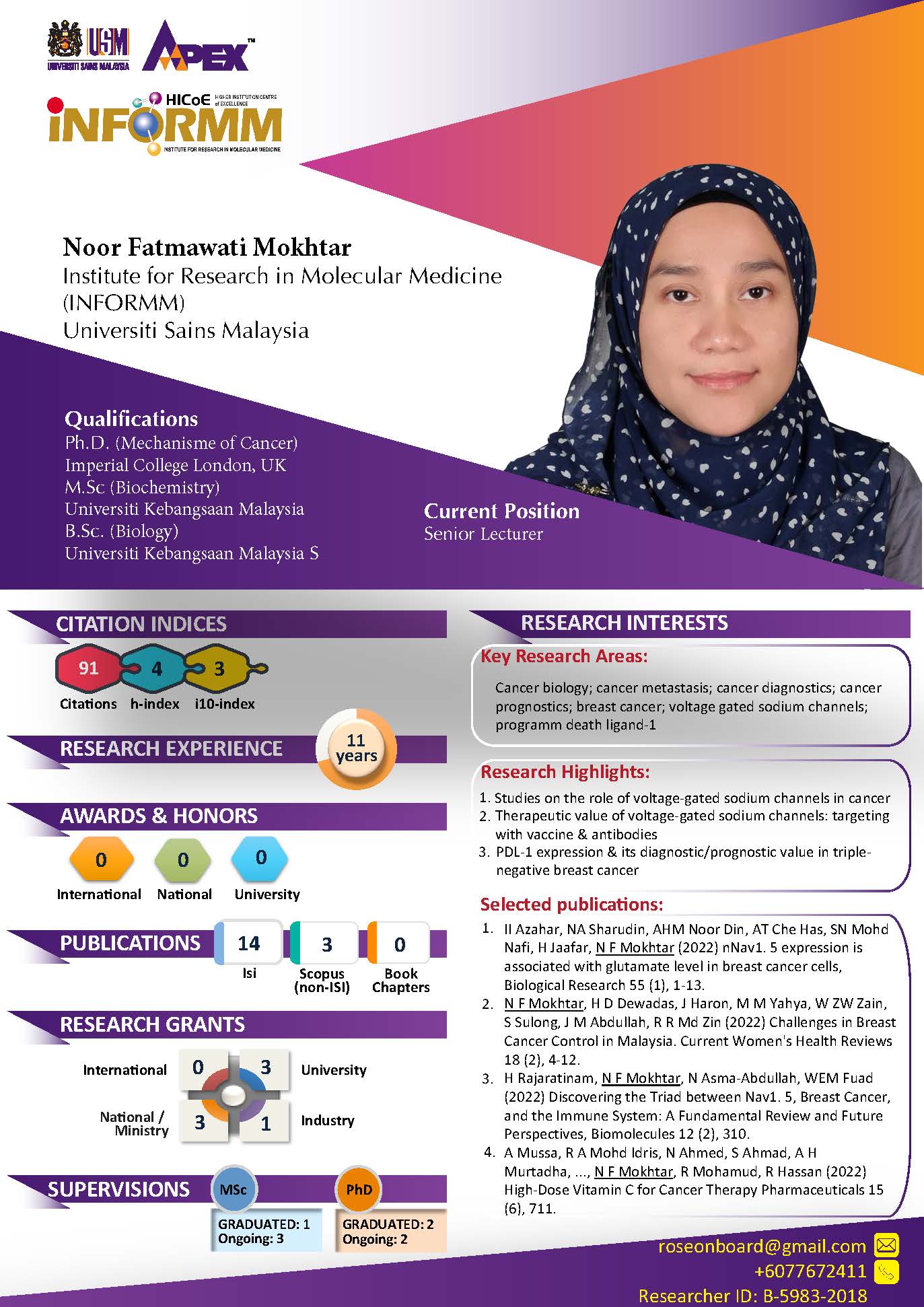Noor Fatmawati Mokhtar


|
Name Noor Fatmawati Mokhtar |
Current Position Senior Lecturer |
|
fatmawati@usm.my |
Office Telephone +609-7672411 |
|
Qualifications
|
Research Interests cancer, breast cancer, metastasis, voltage-gated sodium channels, epigenetics, cancer immunology |
Research Overview 1
The role of hypoxia in controlling voltage-gated sodium channels (VGSCs) induced breast cancer invasiveness
This study was designed mainly to investigate the role of transcription factor, hypoxia inducible factor-1? (HIF-1?) in enhancing the expression of voltage-gated sodium channels (VGSC) particularly the isoforms, Nav1.5 and nNav1.5 in breast cancer that transforms it to become aggressive. siRNA was conducted to knockdown HIF-1? expression in the aggressive MDA-MB-231 cells whilst hypoxia-mimetic agent, cobalt chloride (CoCl2) was used to stabilize HIF-1? in the less aggressive MCF-7 cells. Total RNA and protein were extracted and subjected to real-time PCR and Western blotting. Migration and motility assays were carried out to study effect of treatments (siRNA and CoCl2) on metastatic cell behaviours. Nav1.5, nNav1.5, HIF-1? and CA9 expression were all highly expressed in MDA-MB-231 cells. siRNA caused a significant decreased in HIF-1? expression (mRNA and protein) and HIF-1?-common target gene, CA9. mRNA expression of Nav1.5 but not nNav1.5 was significantly downregulated by siRNA-HIF-1? followed by suppression of migration. When MCF-7 cells were treated with CoCl2, HIF-1? protein, CA9 and Nav1.5mRNA expression was increased significantly but not nNav1.5 followed by enhanced motility and migration. In conclusion, transcription factor, HIF-1? able to regulate Nav1.5 (but not nNav1.5) in breast cancer to promote its aggressiveness.
Research Overview 2
Elucidating the function of repressor element silencing transcription factor (REST) in human breast cancer and its relation with voltage-gated sodium channels (VGSCs)-mediated metastasis
Voltage-gated sodium channels (VGSCs) are increasingly recognized as a molecular signature for aggressive breast cancer. Knowing the compendium of factors that could regulate the expression of VGSCs in breast cancer will further our understanding of metastasis which has caused 90 % of mortality among breast cancer patients. Herein, the association of transcription factor, repressor element silencing transcription factor (REST) in regulating VGSCs (Nav1.5 and ‘neonatal’ Nav1.5) expression and metastasis mediation were investigated. Our preliminary data suggest that there could be an interaction between VGSCs and REST isolated from the weakly breast cancer which is loss in aggressive breast cancer. The loss of REST expression responsible for the upregulation of VGSCs observed in aggarssive breast cancer. Data generated from this research further our understanding on VGSCs aberrant expression in aggressive breast cancer and further demonstrate unique features of VGSCs to be considered as a potential prognostic, diagnostic and therapeutic target to combat aggressive breast cancer.
Selected Publications
1. Maizan Mohamed, Nani Izreen Mohd Sani, Aziana Ismail and Noor Fatmawati Mokhtar (2017) Cytotoxicity and anti-cancer effect of mangrove crab (Scylla Serrata) soup on human leukemic Jurkat cells. Eur J Pharm Med Res, 4(2):192-195.
2. Siti Nur Hasyila Muhammad, Noor Fatmawati Mokhtar and Nik Soriani Yaacob (2016) 15d-PGJ2 induces apoptosis of MCF-7 and MDA-MB-231 cells via increased intracellular calcium and activation of caspases, independently of ER? and ?. Asian Pac J Cancer Prev, 17(7):3223-3228.
3. Aidil Abdul Hamid, Noor Fatmawati Mokhtar, Ekhlass M. Taha, Othman Omar and Wan Mohtar Wan Yusoff (2010) The role of ATP citrate lyase, malic enzyme and fatty acid synthase in the regulation of lipid accumulation in Cunninghamella sp. 2A1. Ann Microbiol, 61:463-468.
Author Links
